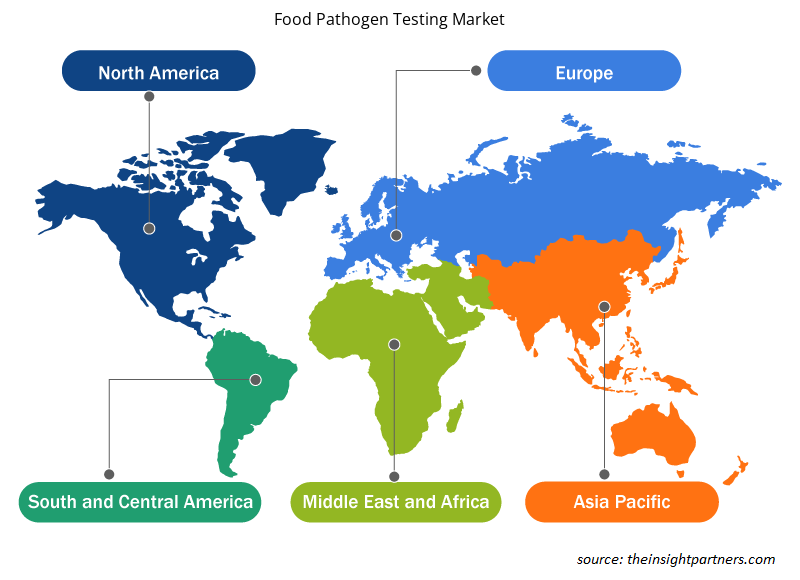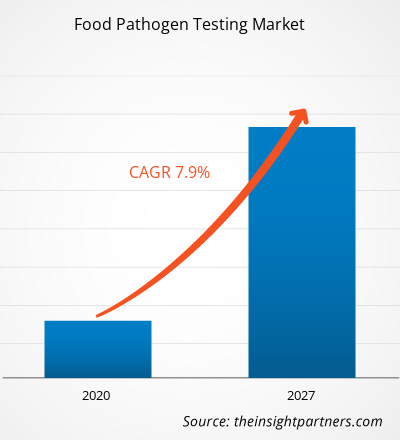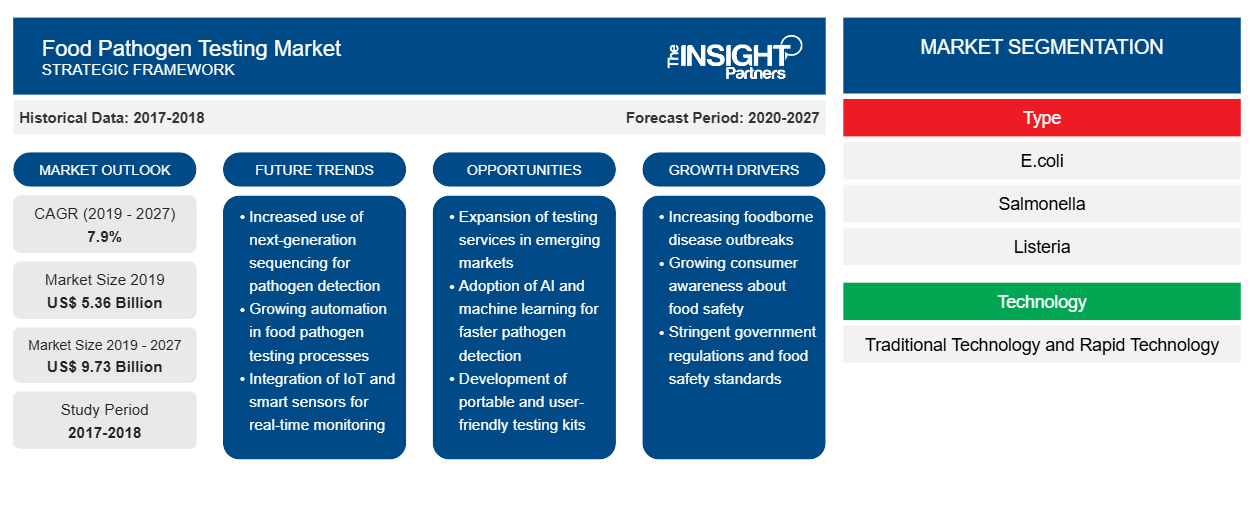بلغت قيمة سوق اختبار مسببات الأمراض الغذائية 5،360.94 مليون دولار أمريكي في عام 2019 ومن المتوقع أن تصل إلى 9،731.91 مليون دولار أمريكي بحلول عام 2027؛ ومن المتوقع أن ينمو بمعدل نمو سنوي مركب قدره 7.9٪ من عام 2020 إلى عام 2027.
يُعرَّف اختبار مسببات الأمراض الغذائية بأنه العملية التي تساعد في مراقبة وجود أي بكتيريا أو ميكروبات تهدد الحياة في الطعام. يعد اختبار مسببات الأمراض الغذائية أمرًا بالغ الأهمية لصناعة الأغذية حيث يوجد حوالي 31 فيروسًا وبكتيريا معروفة تسبب مسببات الأمراض التي يمكن أن تؤدي إلى أمراض ضارة منقولة عن طريق الأغذية. يتم استخدام طريقة الاختبار هذه في كل خطوة من خطوات إنتاج الأغذية لضمان سلامة الأغذية. إن الارتفاع في المخاوف واللوائح المتعلقة بالسلامة بسبب عدد حالات التسمم الغذائي يدفع نمو سوق اختبار مسببات الأمراض الغذائية. أيضًا، فإن التقدم في طرق اختبار مسببات الأمراض الغذائية المختلفة مثل تفاعل البوليميراز المتسلسل والفصل المغناطيسي المناعي ووقت الكشف المحدود يصب في صالح اعتماد اختبار مسببات الأمراض الغذائية من قبل العديد من المشاركين في صناعة الأغذية.
من المتوقع أن ينمو سوق اختبار مسببات الأمراض الغذائية في أوروبا بأعلى معدل نمو سنوي مركب خلال فترة التنبؤ. ويعزى نمو السوق في هذه المنطقة بشكل أساسي إلى ارتفاع حالات الإصابة بالأمراض المنقولة عن طريق الأغذية، وبالتالي فإن الوعي المتزايد بسلامة الأغذية يدفع الطلب على اختبار مسببات الأمراض الغذائية في أمريكا الشمالية. كما يدعم التطور في طرق اختبار مسببات الأمراض إلى جانب التكنولوجيا الحيوية النانوية نمو السوق. كما تعمل الزيادات في النفقات الطبية وتطبيق الكائنات المعدلة وراثيًا في صناعة الأغذية والمشروبات على تغذية السوق بنفس الشيء. تساهم العولمة في تجارة الأغذية والتنمية الاقتصادية في توسيع سوق اختبار مسببات الأمراض الغذائية في المنطقة. يوفر الوعي المتزايد بفوائد استخدام اختبار مسببات الأمراض الغذائية بين المستهلكين ومصنعي الأغذية فرصًا مربحة لتطوير سوق اختبار مسببات الأمراض الغذائية.
قم بتخصيص هذا التقرير ليناسب متطلباتك
ستحصل على تخصيص لأي تقرير - مجانًا - بما في ذلك أجزاء من هذا التقرير، أو تحليل على مستوى الدولة، وحزمة بيانات Excel، بالإضافة إلى الاستفادة من العروض والخصومات الرائعة للشركات الناشئة والجامعات
- احصل على أهم اتجاهات السوق الرئيسية لهذا التقرير.ستتضمن هذه العينة المجانية تحليلاً للبيانات، بدءًا من اتجاهات السوق وحتى التقديرات والتوقعات.
تأثير جائحة كوفيد-19 على سوق اختبار مسببات الأمراض الغذائية
يؤثر تفشي فيروس كورونا المستجد كوفيد-19 سلبًا على الاقتصادات والصناعات في مختلف البلدان بسبب عمليات الإغلاق وحظر السفر وإغلاق الشركات. تعد الأغذية والمشروبات من بين الصناعات المهمة التي تعاني من اضطرابات شديدة مثل القيود المفروضة على سلسلة التوريد وإغلاق مصانع الإنتاج. يؤدي إغلاق المصانع والمصانع المختلفة في مختلف البلدان إلى تعطيل سلاسل التوريد العالمية ويؤثر سلبًا على أنشطة التصنيع وجداول التسليم ومبيعات السلع المتعددة. أعلنت العديد من الشركات بالفعل عن تأخيرات محتملة في تسليم المنتجات وانخفاض في مبيعات منتجاتها في المستقبل. بالإضافة إلى ذلك، فإن حظر السفر العالمي الذي فرضته دول في أوروبا وآسيا وأمريكا الشمالية يعيق التعاون التجاري وفرص الشراكة. وبالتالي، فإن هذه العوامل تقيد نمو سوق اختبار مسببات الأمراض الغذائية في صناعة الأغذية والمشروبات.
رؤى السوق
من المتوقع أن يؤدي زيادة الاختبارات السريعة لمسببات الأمراض في إنتاج الألبان إلى تعزيز نمو سوق اختبار مسببات الأمراض الغذائية
يتم تحسين تقنيات اختبار مسببات الأمراض الغذائية بشكل مستمر وتوظيفها، مع تطور تكنولوجيات سلامة الأغذية. لدى منتجي الألبان هذه الأيام مجموعة متنوعة من الخيارات للاختيار من بينها لاختبار مسببات الأمراض بدقة وسرعة والتي تناسب فئات مختلفة من المنتجات والمرافق وسير العمل. تعتمد تقنيات اختبار مسببات الأمراض الغذائية السريعة على كيمياء مختلفة لغرض الكشف عن مسببات الأمراض المستهدفة بأكثر الطرق فعالية وكفاءة. تستهدف التقنيات القائمة على اختبار الفلورسنت المرتبط بالإنزيم (ELFA) مستقبلات سطح الخلية المحددة على مسببات الأمراض لإجراء تحديد. تستهدف التقنيات القائمة على تفاعل البوليميراز المتسلسل (PCR) الحمض النووي داخل كل من مسببات الأمراض.
إن تطبيق تقنيات الاختبار السريع في مصانع الألبان يوفر العديد من المزايا مثل الوقت الأسرع للحصول على النتائج مما يسمح أيضًا بإجراء اختبارات أعلى طوال الوقت لغرض تحسين كفاءة الإنتاج وتقليل وقت الاحتفاظ وزيادة مدة صلاحية المنتجات. كما أن استخدام تقنيات الاختبار السريع يفضل أيضًا الاستجابة السريعة للأحداث السلبية مما يسمح لمرافق إنتاج الألبان بتنفيذ أي إجراءات تصحيحية مطلوبة يمكن أن تمنع الخسائر الناجمة عن الهدر والتلف. إلى جانب ذلك، فإن طرق اختبار مسببات الأمراض الغذائية السريعة هذه سهلة الاستخدام وتسمح بمرونة متزايدة للموظفين. لقد نفذت معظم شركات تصنيع الألبان برامج اختبار داخلية. مع التدريب المناسب وتوافر الأدوات المناسبة، لم تعد درجة علم الأحياء الدقيقة المتقدمة بمثابة عائق أمام تنفيذ برنامج اختبار مسببات الأمراض الناجح. أيضًا، فإن ارتفاع إمكانية الوصول إلى طرق الاختبار السريع وبأسعار معقولة، تمكن شركات تصنيع الألبان من الاحتفاظ ببياناتها داخل الشركة، وتعزيز إمكانية تتبع العينات والنتائج والتحكم فيها. يساعد تسخير البيانات وإيواءها الشركات المصنعة على استخدام التحليلات واتخاذ قرارات استباقية تتراوح من سلسلة التوريد إلى خط الإنتاج إلى مرافق التخزين. بفضل المزايا التي توفرها الاختبارات السريعة لمسببات الأمراض، يقوم مصنعو الألبان بتنفيذها في وحدات التصنيع الخاصة بهم، مما يعزز بدوره نمو سوق اختبارات مسببات الأمراض الغذائية.
رؤى النوع
اعتمادًا على النوع، ينقسم سوق اختبار مسببات الأمراض الغذائية إلى مبيضة وطبيعية.استحوذ قطاع السالمونيلا على حصة سوقية أكبر في عام 2018، ومن المتوقع أن يسجل معدل نمو سنوي مركب أعلى في السوق خلال الفترة المتوقعة.السالمونيلا هي أكثر أنواع الأمراض البكتيرية شيوعًا والتي تصيب القناة المعوية لجسم الإنسان. وهي تسبب الإسهال وتشنجات البطن والحمى. وتحدث غالبًا بسبب تناول اللحوم والدواجن ومنتجات البيض النيئة أو غير المطبوخة جيدًا. وتضعف عدوى السالمونيلا الجهاز المناعي خاصة عند الرضع والنساء والبالغين. وفي بعض الأحيان تكون مهددة للحياة وبالتالي يتم إجراء اختبار مسببات الأمراض الغذائية في الغالب للكشف عن السالمونيلا. إن خطر الإصابة بعدوى السالمونيلا مرتفع للغاية ويصاب الناس بها بسهولة. وبالتالي، من أجل منع هذه العدوى وخسارة الأرواح البشرية، تلعب اختبارات مسببات الأمراض الغذائية دورًا مهمًا للغاية في هذا القطاع، مما يؤدي بدوره إلى نموها في سوق اختبار مسببات الأمراض الغذائية.
رؤى حول أنواع الطعام
بناءً على نوع الطعام، يتم تقسيم سوق اختبار مسببات الأمراض الغذائية إلى اللحوم والدواجن ومنتجات الألبان والأغذية المصنعة والفواكه والخضروات والحبوب والبقوليات. شكلت شريحة اللحوم والدواجن أكبر حصة سوقية في عام 2018. زاد استهلاك اللحوم العالمي بشكل هائل بسبب فوائدها الصحية، مثل تحسين تناول البروتين إلى جانب زيادة الإنفاق على العشاء في الهواء الطلق. إن الحاجة إلى تحسين جودة المنتج أو الحفاظ عليها بسبب الوعي المتزايد لدى المستهلك والوعي الصحي تدفع الطلب على اختبار مسببات الأمراض الغذائية. إن تطوير اللوائح المنسوبة إلى زيادة تفشي مسببات الأمراض الغذائية من خلال منتجات الدواجن واللحوم والمأكولات البحرية تعمل على تضخيم نمو القطاع. أهم مسببات الأمراض المرتبطة باللحوم والدواجن هي الإشريكية القولونية والكامبيلوباكتر والسالمونيلا. تؤدي الظروف غير الصحية والتعامل غير السليم أثناء السلخ وإزالة الريش إلى التلوث المتوقع الذي يدعم نمو هذا القطاع.
رؤى التكنولوجيا
بناءً على التكنولوجيا، يتم تقسيم سوق اختبار مسببات الأمراض الغذائية إلى التكنولوجيا التقليدية والتكنولوجيا السريعة. شكلت شريحة التكنولوجيا السريعة أكبر حصة سوقية في عام 2018. تدعم الخطوات البسيطة والتكلفة الأولية المنخفضة المرتبطة بالتكنولوجيا التقليدية نمو القطاع. لديها مزايا مختلفة، مثل انخفاض التكلفة وزيادة الدقة، والتي من المرجح أن تدفع نمو هذا القطاع. على الرغم من أن التكنولوجيا التقليدية دقيقة للغاية، إلا أنها تتطلب قدرًا كبيرًا من الوقت للكشف عن مسببات الأمراض. في بعض الأحيان يستغرق الأمر أيامًا إلى أسابيع. علاوة على ذلك، تغيرت مختبرات علم الأحياء الدقيقة الغذائية بشكل كبير خلال الثلاثين عامًا الماضية. خلال أوائل الثمانينيات، كان التركيز على اختبار مراقبة الجودة، والذي تم إجراؤه داخليًا من قبل الشركات المصنعة. ومع ذلك، مع بدء الصناعة في تبني نهج تحليل المخاطر ونقاط التحكم الحرجة لإدارة سلامة الأغذية، تم استبدال مراقبة الجودة بضمان الجودة. بدلاً من الكشف، أصبحت الوقاية هدفًا لمراقبة سلامة الأغذية، وتم الاستعانة بمصادر خارجية لمعظم الاختبارات الميكروبيولوجية المتبقية. استمرت التقنيات التقليدية في الاعتماد على زراعة الكائنات الحية الدقيقة في عينة لإنتاج خلايا كافية للكشف. وتستغرق هذه الخطوة في الثقافة 24 ساعة على الأقل، وبالنسبة لبعض مسببات الأمراض، تستغرق خمسة أيام أو أكثر. ولم تكن الطرق التقليدية قادرة على تقديم النتائج بسرعة كافية لمراقبة نقاط التحكم الحرجة في نظام تحليل المخاطر ونقاط التحكم الحرجة بشكل فعال، وتُستخدم حاليًا بشكل أساسي للتحقق من أن النظام يعمل بشكل صحيح.
من بين الشركات القليلة العاملة في سوق اختبار مسببات الأمراض الغذائية SGS SA وBureau Veritas وIntertek Group Plc وEurofins Scientific وMérieux NutriSciences وifp Institut für Produktqualität GmbH وALS Limited وAsureQuality وMicrobac Laboratories وFoodChain ID Group Inc وغيرها الكثير. تنفذ الشركات الرئيسية عمليات الدمج والاستحواذ واستراتيجيات البحث والتطوير لتوسيع قاعدة العملاء والحصول على حصة كبيرة في السوق العالمية، مما يسمح لها أيضًا بالحفاظ على اسم علامتها التجارية عالميًا.
رؤى إقليمية حول سوق اختبار مسببات الأمراض الغذائية
لقد قام المحللون في Insight Partners بشرح الاتجاهات والعوامل الإقليمية المؤثرة على سوق اختبار مسببات الأمراض الغذائية طوال فترة التوقعات بشكل شامل. يناقش هذا القسم أيضًا قطاعات سوق اختبار مسببات الأمراض الغذائية والجغرافيا في جميع أنحاء أمريكا الشمالية وأوروبا ومنطقة آسيا والمحيط الهادئ والشرق الأوسط وأفريقيا وأمريكا الجنوبية والوسطى.

- احصل على البيانات الإقليمية المحددة لسوق اختبار مسببات الأمراض الغذائية
نطاق تقرير سوق اختبار مسببات الأمراض الغذائية
| سمة التقرير | تفاصيل |
|---|---|
| حجم السوق في عام 2019 | 5.36 مليار دولار أمريكي |
| حجم السوق بحلول عام 2027 | 9.73 مليار دولار أمريكي |
| معدل النمو السنوي المركب العالمي (2019 - 2027) | 7.9% |
| البيانات التاريخية | 2017-2018 |
| فترة التنبؤ | 2020-2027 |
| القطاعات المغطاة | حسب النوع
|
| المناطق والدول المغطاة | أمريكا الشمالية
|
| قادة السوق وملفات تعريف الشركات الرئيسية |
|
كثافة اللاعبين في السوق: فهم تأثيرها على ديناميكيات الأعمال
يشهد سوق اختبار مسببات الأمراض الغذائية نموًا سريعًا، مدفوعًا بالطلب المتزايد من المستخدم النهائي بسبب عوامل مثل تفضيلات المستهلك المتطورة والتقدم التكنولوجي والوعي المتزايد بفوائد المنتج. ومع ارتفاع الطلب، تعمل الشركات على توسيع عروضها والابتكار لتلبية احتياجات المستهلكين والاستفادة من الاتجاهات الناشئة، مما يؤدي إلى زيادة نمو السوق.
تشير كثافة اللاعبين في السوق إلى توزيع الشركات أو المؤسسات العاملة في سوق أو صناعة معينة. وهي تشير إلى عدد المنافسين (اللاعبين في السوق) الموجودين في مساحة سوق معينة نسبة إلى حجمها أو قيمتها السوقية الإجمالية.
الشركات الرئيسية العاملة في سوق اختبار مسببات الأمراض الغذائية هي:
- شركة اس جي اس اس ايه
- مكتب فيريتاس
- مجموعة إنترتك المحدودة
- يوروفينز العلمية
- ميريو نوتريساينسز.
إخلاء المسؤولية : الشركات المذكورة أعلاه ليست مرتبة بأي ترتيب معين.

- احصل على نظرة عامة على أهم اللاعبين الرئيسيين في سوق اختبار مسببات الأمراض الغذائية
تقرير يسلط الضوء على
- اتجاهات الصناعة التقدمية في سوق اختبار مسببات الأمراض الغذائية لمساعدة اللاعبين على تطوير استراتيجيات فعالة طويلة الأجل
- استراتيجيات نمو الأعمال التي تتبناها الأسواق المتقدمة والنامية
- التحليل الكمي لسوق اختبار مسببات الأمراض الغذائية من 2019 إلى 2027
- تقدير الطلب العالمي على اختبارات مسببات الأمراض الغذائية
- تحليل PEST لتوضيح فعالية المشترين والموردين العاملين في الصناعة
- التطورات الأخيرة لفهم سيناريو السوق التنافسي
- اتجاهات السوق وتوقعاته بالإضافة إلى العوامل التي تدفع وتكبح نمو سوق اختبار مسببات الأمراض الغذائية
- المساعدة في عملية اتخاذ القرار من خلال تسليط الضوء على استراتيجيات السوق التي تدعم المصلحة التجارية، مما يؤدي إلى نمو السوق
- حجم سوق اختبار مسببات الأمراض الغذائية في العقد المختلفة
- نظرة عامة مفصلة وتقسيم السوق، بالإضافة إلى ديناميكيات صناعة اختبار مسببات الأمراض الغذائية
- حجم سوق اختبار مسببات الأمراض الغذائية في مناطق مختلفة مع فرص نمو واعدة
سوق اختبار مسببات الأمراض الغذائية حسب النوع
- الإشريكية القولونية
- السالمونيلا
- ليستيريا
- كامبيلوباكتر
- آحرون
سوق اختبار مسببات الأمراض الغذائية – حسب التكنولوجيا
- التكنولوجيا التقليدية
- التكنولوجيا السريعة
سوق اختبار مسببات الأمراض الغذائية – حسب نوع الغذاء
- اللحوم والدواجن
- ألبان
- الأغذية المصنعة
- الفواكه والخضروات
- الحبوب والحبوب
ملفات تعريف الشركة
- شركة اس جي اس اس ايه
- مكتب فيريتاس
- مجموعة إنترتك المحدودة
- يوروفينز العلمية
- ميريو نوتريساينسز.
- IFP Institut für Produktqualität GmbH
- شركة ALS المحدودة
- أشور كواليتي
- مختبرات ميكروباك
- مجموعة فود تشين آي دي
- التحليل التاريخي (سنتان)، سنة الأساس، التوقعات (7 سنوات) مع معدل النمو السنوي المركب
- تحليل PEST و SWOT
- حجم السوق والقيمة / الحجم - عالمي، إقليمي، بلد
- الصناعة والمنافسة
- مجموعة بيانات إكسل
التقارير الحديثة
تقارير ذات صلة
شهادات العملاء
سبب الشراء
- اتخاذ قرارات مدروسة
- فهم ديناميكيات السوق
- تحليل المنافسة
- رؤى العملاء
- توقعات السوق
- تخفيف المخاطر
- التخطيط الاستراتيجي
- مبررات الاستثمار
- تحديد الأسواق الناشئة
- تحسين استراتيجيات التسويق
- تعزيز الكفاءة التشغيلية
- مواكبة التوجهات التنظيمية





















 احصل على عينة مجانية ل - سوق اختبار مسببات الأمراض الغذائية
احصل على عينة مجانية ل - سوق اختبار مسببات الأمراض الغذائية